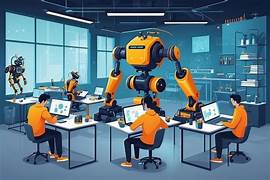AI-Driven Swarm Robotics for Collective Tasks
Swarm robotics, inspired by the collective behaviors of social insects such as bees, ants, and termites, has emerged as a revolutionary field in robotics. The integration of Artificial Intelligence (AI) in swarm robotics enhances the ability of multiple robots to collaborate efficiently, adapting to dynamic environments and solving complex tasks. This synergy has significant implications across industries, ranging from agriculture and disaster response to healthcare and logistics.
This article delves into the concept of AI-driven swarm robotics, how it works, its applications, challenges, and the potential it holds for future innovations.
What is Swarm Robotics?
Swarm robotics is a branch of robotics that focuses on coordinating large groups of simple robots to perform collective tasks. Unlike individual robots with sophisticated designs, swarm robotics relies on:
- Decentralized Control: No single robot governs the entire group; decisions emerge from local interactions.
- Scalability: The system can function effectively whether the swarm consists of a few robots or thousands.
- Robustness: The failure of individual robots does not compromise the overall system’s functionality.
AI algorithms play a crucial role in enabling these robots to communicate, adapt, and work towards a shared objective, emulating natural swarms’ efficiency.
How AI Drives Swarm Robotics
AI technologies power swarm robotics by enhancing decision-making, communication, and adaptation. Several key AI methodologies contribute to the functionality of robotic swarms:
1. Machine Learning
- AI enables robots to learn from their environment and past experiences.
- Reinforcement learning helps robots improve task execution, such as finding the shortest path or optimizing resource allocation.
2. Deep Neural Networks
- Neural networks process sensory data (e.g., images, sounds) to help robots understand their surroundings.
- AI-driven models allow robots to make real-time decisions in complex and dynamic environments.
3. Optimization Algorithms
- Algorithms inspired by natural phenomena, such as ant colony optimization and particle swarm optimization, enable efficient coordination among robots.
- These methods help the swarm achieve goals like locating resources or mapping environments.
4. Communication Protocols
- AI ensures seamless communication among robots through decentralized systems, enabling them to share information and coordinate actions.
5. Sensor Fusion
- AI integrates data from multiple sensors (e.g., cameras, LiDAR, and GPS) to provide a comprehensive understanding of the environment, guiding the swarm’s behavior.
Applications of AI-Driven Swarm Robotics
AI-powered swarm robotics is transforming numerous fields by addressing challenges that require collective effort and adaptability.
1. Disaster Response and Search & Rescue
- Swarm robots can be deployed in disaster-stricken areas to locate survivors, assess damage, and deliver supplies.
- Equipped with AI, these robots navigate through rubble, map hazardous zones, and operate collaboratively, outperforming human teams in speed and safety.
2. Agriculture
- AI-driven robotic swarms can monitor crops, identify pests, and optimize irrigation.
- These robots work collectively to plant seeds, remove weeds, and apply fertilizers, increasing efficiency while reducing the need for harmful chemicals.
3. Environmental Monitoring
- Swarm robots equipped with AI sensors are used to monitor ecosystems, track pollution levels, and study wildlife.
- For example, underwater robotic swarms can map coral reefs, detect oil spills, and track marine life behaviors.
4. Warehousing and Logistics
- Swarm robotics streamlines inventory management and order fulfillment.
- AI-enabled robots coordinate to retrieve, sort, and transport goods efficiently, minimizing human effort and errors.
5. Military and Defense
- AI-driven robotic swarms are employed for reconnaissance, surveillance, and tactical operations.
- These robots can swarm targets, neutralize threats, or establish secure communication networks in conflict zones.
6. Healthcare
- In medical applications, nanorobotic swarms are guided by AI to perform targeted drug delivery or non-invasive surgical procedures.
- On a larger scale, swarm robots can sanitize hospital spaces or transport medical supplies.
7. Smart Cities
- AI-powered swarms manage urban tasks such as traffic monitoring, waste collection, and infrastructure inspection.
- These systems ensure real-time adaptability, improving urban efficiency and reducing costs.
Advantages of AI-Driven Swarm Robotics
The integration of AI offers several advantages to swarm robotics:
- Efficiency: AI optimizes resource use, allowing swarms to complete tasks faster and with minimal redundancy.
- Flexibility: Robots can adapt to changing environments and tasks without requiring reprogramming.
- Scalability: The system performs consistently, whether with a small or large number of robots.
- Resilience: The swarm can continue functioning even if individual robots fail.
- Cost-Effectiveness: Using simple robots reduces hardware costs while AI enhances overall system intelligence.
Challenges in AI-Driven Swarm Robotics
Despite its potential, AI-driven swarm robotics faces several challenges:
1. Complexity of Coordination
- Synchronizing large numbers of robots in real-time requires advanced algorithms and robust communication protocols.
2. Energy Consumption
- The computational power required for AI processes and inter-robot communication can strain battery life, limiting operational duration.
3. Reliability and Robustness
- Environmental factors such as weather, terrain, or signal interference can disrupt swarm operations.
- Ensuring reliable hardware and software systems for long-term deployments is challenging.
4. Ethical Concerns
- Military applications raise questions about accountability and potential misuse.
- Autonomous decision-making in high-stakes scenarios (e.g., disaster response) poses ethical dilemmas.
5. Security Risks
- Swarm systems are vulnerable to hacking or malicious interference, potentially leading to catastrophic outcomes.
6. Scalability in Practice
- While scalability is a theoretical advantage, real-world applications face limitations in terms of cost, infrastructure, and maintenance.
The Future of AI-Driven Swarm Robotics
AI-driven swarm robotics holds immense potential for future innovations. Some trends and developments to watch for include:
1. Advanced AI Algorithms
- Improved algorithms will enhance decision-making, adaptability, and communication among robots, making them more efficient in diverse scenarios.
2. Human-Swarm Interaction
- Integrating human input with swarm behavior will create hybrid systems where humans guide robots to achieve complex goals.
3. Autonomous Infrastructure Maintenance
- Swarm robots could inspect, repair, and maintain critical infrastructure such as bridges, pipelines, and power grids without human intervention.
4. Space Exploration
- Robotic swarms guided by AI will play a vital role in exploring extraterrestrial environments, building habitats, and conducting resource extraction.
5. Ethical and Regulatory Frameworks
- Governments and organizations will develop guidelines to address ethical concerns, ensuring safe and responsible deployment.
Conclusion
AI-driven swarm robotics represents a groundbreaking advancement in collective problem-solving. By leveraging decentralized control, AI algorithms, and real-time adaptability, these robotic systems are transforming industries ranging from disaster response to healthcare.
However, realizing the full potential of swarm robotics requires addressing technical challenges, ethical concerns, and security risks. As AI technologies continue to evolve, swarm robotics will play an increasingly critical role in tackling some of humanity’s most pressing challenges, paving the way for a more efficient and interconnected future.


